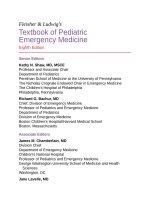Pediatric emergency medicine trisk 0311 0311
Bạn đang xem bản rút gọn của tài liệu. Xem và tải ngay bản đầy đủ của tài liệu tại đây (104.3 KB, 1 trang )
institution. Flexibility in personnel, equipment, and medication availability leads
to better outcomes.
FIGURE 11.3 An example of a pretransport safety checklist. (Used with permission, © The
Children’s Hospital of Philadelphia, Philadelphia, PA.)
Orr et al. in 2001 presented predictive models to help appropriately triage and
critically assess pediatric transport systems. Their research suggests several
factors are useful in predicting in-hospital mortality for transported patients.
These include blood pressure, respiratory rate, oxygen requirement, and altered
mental status. They also found that the risk of mortality increases with
performance of major interventions, as did the occurrence of unplanned events.
Some researchers have looked at the Shock Index (SI) in an attempt to determine
stability and level of illness, while others use specific triage tools to determine
optimal response required (Advanced Life Support [ALS], level of CCT) for each









